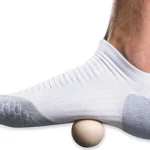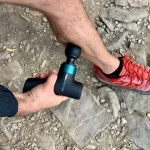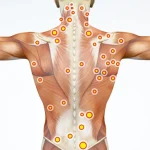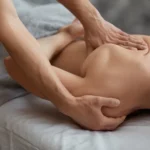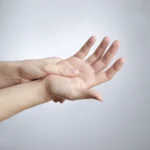Plantar fasciitis is one of the most common sources of heel pain, especially for people who walk long distances, work on hard floors, or spend hours standing each day. The discomfort can become sharp, persistent, and frustrating—particularly during those first steps in the morning. While stretching, strengthening, and footwear changes all play critical roles in long-term recovery, learning how to massage plantar fasciitis correctly can help relieve symptoms more quickly and make daily movement easier.
Massage works by reducing tension in the plantar fascia, improving circulation, loosening tight calf muscles, and supporting healthier foot mechanics. When practiced consistently, the right techniques help you manage pain, restore mobility, and take pressure off the inflamed heel area.
Table of Contents
What is Plantar Fasciitis?

The plantar fascia is a thick, fibrous band that supports your arch and provides the spring-like motion your foot relies on for walking, running, and absorbing impact. When this band becomes overstressed—usually from tight calves, poor shoe support, sudden increases in activity, or prolonged standing—it can irritate the heel attachment and lead to inflammation.
Most people notice pain during their first steps in the morning or after sitting for long periods. The fascia tightens while you rest and becomes overstretched when weight is applied. Massage helps counteract this cycle by restoring tissue mobility, reducing tension, and supporting the fascia’s natural ability to glide more comfortably.
For readers wanting broader foot care techniques, you can explore a general foot massage guide here:
👉 How To Give A Foot Massage
How to Massage Plantar Fasciitis: The Most Effective Techniques 💆♂️
The following techniques are the most reliable and widely recommended for reducing plantar fasciitis pain. Each method targets a different component of the fascia and surrounding muscle groups, helping restore function and reduce the strain that contributes to heel pain.
Deep Friction Massage for Heel Pain 🔥
Deep friction massage focuses on the irritated area where the plantar fascia attaches to the heel. Sit comfortably and place your ankle over the opposite knee. Use your thumb to press into the inner heel—an area that often feels tender—and move your thumb in slow, controlled strokes across the tissue. The motion should run perpendicular to the fascia’s direction, not along it. This type of crosswise friction helps realign irritated fibers, reduce stiffness, and ease pressure on the heel during walking. A minute of steady, moderate pressure is usually enough to create a noticeable change.
Cross-Fiber Massage for Arch Release 🌈
The plantar fascia runs lengthwise beneath the foot, so targeting it from side to side is often more effective than moving along the arch. Place your thumb in the center of your arch and apply firm, steady pressure. Move horizontally across the foot, allowing your thumb to sweep gently over the tight band. After several passes, the tissue usually begins to soften, making it easier to walk and stand without discomfort. Performing this technique regularly helps restore pliability in the fascia, which is essential for long-term relief.

Trigger Point Release for Sharp Foot Pain 🎯
If you find a highly sensitive spot that produces a sharper sensation, it’s likely a trigger point. These occur when tight fibers in the fascia or small muscles of the foot become overloaded. Apply steady, moderate pressure using your thumb, knuckle, or a massage ball. Hold until the intensity eases—usually twenty to thirty seconds. The goal isn’t to push through pain but to wait for the tissue to release. Trigger point work improves the foot’s tolerance to daily movement and reduces the sudden spikes of heel pain many people experience.
Myofascial Release for Gentle Tissue Lengthening ✨
During flare-ups, the foot can feel too tender for deep work. Myofascial release offers a more forgiving option. With your thumb or knuckles, apply slow, steady pressure along the arch, moving at a pace of no more than one inch per second. The sensation should feel like gradual lengthening rather than intense pressure. This technique encourages natural tissue mobility and is particularly helpful before stretching or using a foot massager.
If you prefer tools, explore this guide on using a foot massager:
👉 How To Use A Foot Massager
Calf Massage to Reduce Plantar Fascia Load 🦵
Tight calves are one of the strongest contributors to plantar fasciitis because they limit ankle mobility and place extra strain on the fascia with every step. Massage the calf using slow strokes upward from the ankle, focusing on areas that feel tight or rope-like. As the calf relaxes, the plantar fascia is able to function with far less tension. Many people experience immediate heel pain relief once the calf muscles release, making this an essential step in managing plantar fasciitis.
You can learn more about calf relief here:
👉 How To Massage Tight Calf Muscles
Rolling Massage with a Ball or Cold Bottle ❄️
Using a massage ball, lacrosse ball, or frozen bottle provides controlled pressure and reduces inflammation at the same time. Place the tool under your arch and slowly roll from the heel to the toes. The movement should be deliberate rather than fast. Slow circles over sensitive areas can help loosen tension, but avoid pressing into sharp pain. Two or three minutes of rolling is usually enough to relax the fascia without overstressing it.
Benefits of Massaging Plantar Fasciitis 🌟
Massage offers meaningful, practical benefits when treating plantar fasciitis. It improves circulation around the irritated heel, helping the tissue receive nutrients necessary for repair. It loosens the stiff arch and calf muscles that often worsen symptoms and limit ankle mobility. Many people find that morning massage reduces the sharp, stabbing pain they typically feel during their first steps.
Massage also complements strengthening programs by reducing background tension in the foot, allowing exercises such as calf raises and eccentric loading drills to work more effectively. The combination of massage, targeted exercise, supportive footwear, and proper load management offers the strongest path to long-term improvement.
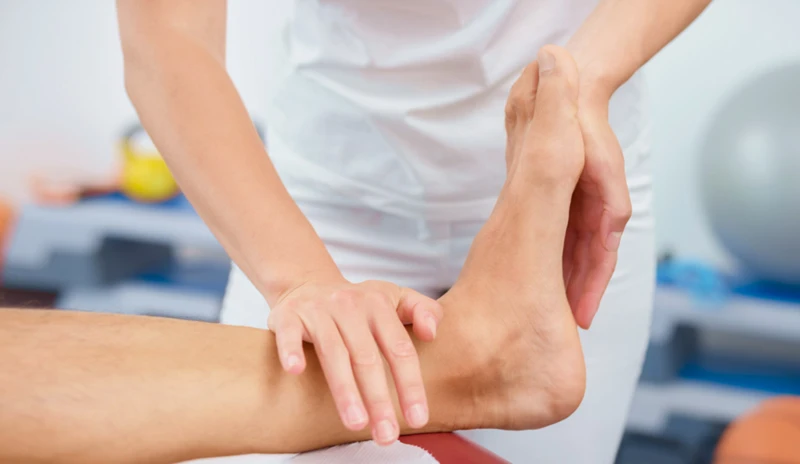
When to Seek Professional Help 🩺
Although massage provides relief for many individuals, persistent or escalating symptoms require a professional assessment. Seek help from a podiatrist or physiotherapist if your heel pain lasts longer than four to six weeks despite home care, if you experience swelling or redness, or if weight-bearing becomes difficult. A clinician can determine whether your symptoms are caused by plantar fasciitis or a different condition such as Baxter’s nerve entrapment or a stress fracture. Early evaluation prevents chronic issues and ensures you receive the most appropriate treatment plan.
Safety Considerations ⚠️
Massage should not provoke sharp pain. If your heel or arch feels inflamed, tender, or swollen, begin with gentle techniques or calf release rather than deep pressure. Individuals with diabetes should inspect their feet for wounds prior to massage and proceed cautiously. Avoid massaging over bruises, cuts, infections, or areas of numbness. If you notice increased discomfort within twenty-four hours of massage, reduce the intensity or pause treatment. Steady, controlled movements are always more effective than force.
Frequently Asked Questions About How to Massage Plantar Fasciitis
How often should I massage plantar fasciitis?
Most people benefit from short sessions once or twice a day. Two to five minutes of focused work is more effective than long, aggressive massage. The right pressure should lead to easier walking, reduced morning pain, and fewer sharp sensations during daily movement. If discomfort increases after massage, lighten the pressure or shorten the session.
Should plantar fasciitis massage hurt?
A mild pulling or pressure sensation is normal, but massage should never create sharp or burning pain. Productive discomfort usually fades as the tissue releases. If pain intensifies or lingers afterward, shift to gentler techniques such as myofascial release or calf massage. The goal is controlled relief, not irritation.
Is rolling my foot on a ball safe for plantar fasciitis?
Yes—rolling is safe when performed slowly and with moderate weight. A massage ball or frozen bottle helps decrease inflammation and release tension in the arch. Move deliberately rather than quickly, and adjust pressure as needed. If rolling produces sharp pain, reduce your body weight on the tool or pause the session.
Should I massage my calves to help plantar fasciitis heal?
Absolutely. Calf tightness places significant strain on the plantar fascia and often contributes directly to heel pain. Releasing the calves improves ankle mobility, reduces tension on the heel, and makes daily movement easier. Many people experience immediate relief after addressing calf tightness.

Conclusion
Learning how to massage plantar fasciitis effectively gives you a powerful tool for managing heel pain and restoring comfortable movement. Consistent massage—combined with stretching, strengthening, and supportive footwear—helps reduce irritation, improve mobility, and support long-term recovery. If pain persists or worsens, consult a professional to rule out other causes and guide your treatment plan.
🔗 Next Steps for Heel Pain Relief
If you’d like to build a complete recovery routine around your massage work, explore these helpful guides:
- 👉 How to Massage Calf Muscles for Heel Pain
- 👉 How to Give a Good Foot Massage
- 👉 How to Use a Foot Massager (Tools That Help Plantar Fasciitis)
- 👉 How to Use a Massage Ball for Plantar Fasciitis Relief
These resources expand on the techniques in this article and support long-term plantar fascia recovery.
📚 References
Cleveland Clinic – Plantar Fasciitis
American Academy of Orthopaedic Surgeons – Plantar Fascititis
American Orthopaedic Foot & Ankle Society – Plantar Fasciitis and Bone Spurs
Mayo Clinic: Plantar Fasciitis
⚠️ Disclaimer:
This article is for informational purposes only and does not constitute medical advice. Always consult with a licensed healthcare provider or certified massage therapist before beginning any new treatment, especially if you have pre-existing health conditions or concerns.


